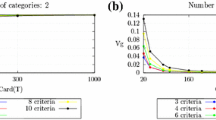Abstract
In this paper we introduce the method of correspondence analysis (CA) to a stochastic multicriteria problem in order to provide solutions that can support the descriptive problematic. These solutions are given in the form of new criteria-axes and the functions of factors. We interpret these functions in terms of the uniform conditional stochastic order. In case, where the first axis provides us with a significant percentage of information, we suggest a ranking of actions which approaches the usual stochastic order.







Similar content being viewed by others
References
Arrow KJ, Hahn FH (1973) General competitive analysis, San Francisco, Holden Day, pp 83–87
Benzecri J-P (1973) L’ Analyse des Donnees, Tome II: L’ analyse des Correspondances. Dunod, Paris
Brans JP, Mareschal B (1990) The PROMETHEE methods for MCDM; The PROMCALC, GAIA and BANKADVISER software. In: Bana e Costa CA (ed) Readings in multiple criteria decision aid. Springer, Berlin, pp 216–251
Cailliez F, Pages J-P (1976) Introduction a l’ analyse des donnees. Smash, Paris
Cheung Y-L (1989) Correspondence analysis: a descriptive technique to simplify the structure of the problems, Working Paper series. School of business, Hong Kong
Cheung Y-L (1991a) Correspondence analysis as an aid to multicriteria decision making. OMEGA 19(2/3):149–155
Cheung Y-L (1991b) Categorical criteria values: correspondence analysis. OMEGA 22(4):371–380
Clark D, Rivett BHP (1976) A structural mapping to complex decision-making. J Oper Res Soc 29(2):113–128
D’ Avignon GR, Vincke Ph (1988) An outranking method under uncertainty. Eur J Oper Res 36:311–321
Dobson R, Golob TF, Gustafson RL (1974) Multidimensional scaling of consumer preferences for a public transportation system: an application of two approaches. Soc Econ Plan 8:28–36
Gifi A (1990) Nonlinear multivariate analysis. Wiley, New York
Gilula Z, Krieger A, Ritov Y (1988) Ordinal association in contingency tables: some interpretive aspects. J Am Stat Assoc 83(402):540–545
Glustoff E (1975) On continuous utility: The Euclidean distance approach. Q J Econom 512–517
Greenacre MJ (1984) Theory and applications of correspondence analysis. Academic Press, London
Heiser WJ (2004) Geometric representation of association between categories. Psychometrica 69(4):513–545
Heiser WJ, Meulman (1983)Analyzing rectangular tables by joint and constrained multidimensional scaling. J Econom 22:139–167
Hill MO (1974) Correspondence analysis: a neglected multivariate method. Appl Stat 23(3):340–354
Keeney RL, Raiffa H (1976) Decision with multiple objectives. Wiley, New York
Krantz D (1967) Rational distance functions for multidimensional scaling. J Math Psychol 4:226–245
Lebart L, Fenelon JP (1979) Informatique et statistique appliqués. Dunod, Paris
Loukas D, Papadimitriou I (2005) Introduction of correspondence analysis to the MCDA process. Data Anal Bull 6:62–75
Matsatsinis NF, Avgerinopoylos E, Baourakis G (1995) Data analysis methods applied to agricultural marketing. In: Janssen J, Skiadas CH, Zopounidis C (eds) Advances in stochastic modeling and data analysis. Kluwer, Dordecht
Mood AM, Graybill FA (1963) Introduction to the theory of statistics. Mc Craw-Hill, New York
Muller A, Stoyan D (2002) Comparison models for stochastic models and risks. Wiley, Chichester
Ritov Y, Gilula Z (1993) Analysis of contingency tables by correspondence analysis models subject to order constraint. J Am Stat Assoc 88(424):1380–1387
Roy B (1996) Multicriteria methodology for decision aiding. Kluwer, Dordrecht
Shaked M, Schantikumar JG (1994) Stochastic orders and their applications. Academic press, New York
Siskos Y, Grigoroudis E, Matsatsinis NF, Baourakis GH (1995) Comparative behavioral analysis of European oil consumers. In: Janssen J, Skiadas CH, Zopounidis C (eds) Advances in stochastic modelling and data analysis. Kluwer, Dordecht
Stewart TJ (1981) A descriptive approach to multiple-criteria decision making. J Oper Res Soc 32:45–33
Stewart TJ (1992) A critical survey on the status of multiple-criteria decision making: theory and practice. OMEGA 20(5/6):569–586
Whitt W (1980) Uniform conditional stochastic order. J Appl Prob 17(1):112–123
Whitt W (1985) Uniform conditional variability ordering of probability distributions. J Appl Prob 22(3):619–633
Zeleny M (1974) A concept of the compromise solutions and the method of displaced ideal. Comp Ops Res 1:479–496
Author information
Authors and Affiliations
Corresponding author
Rights and permissions
About this article
Cite this article
Loukas, D. A descriptive-analytic approach to MCDA: the case of correspondence analysis. Oper Res Int J 8, 141–152 (2008). https://doi.org/10.1007/s12351-008-0010-x
Received:
Revised:
Accepted:
Published:
Issue Date:
DOI: https://doi.org/10.1007/s12351-008-0010-x




